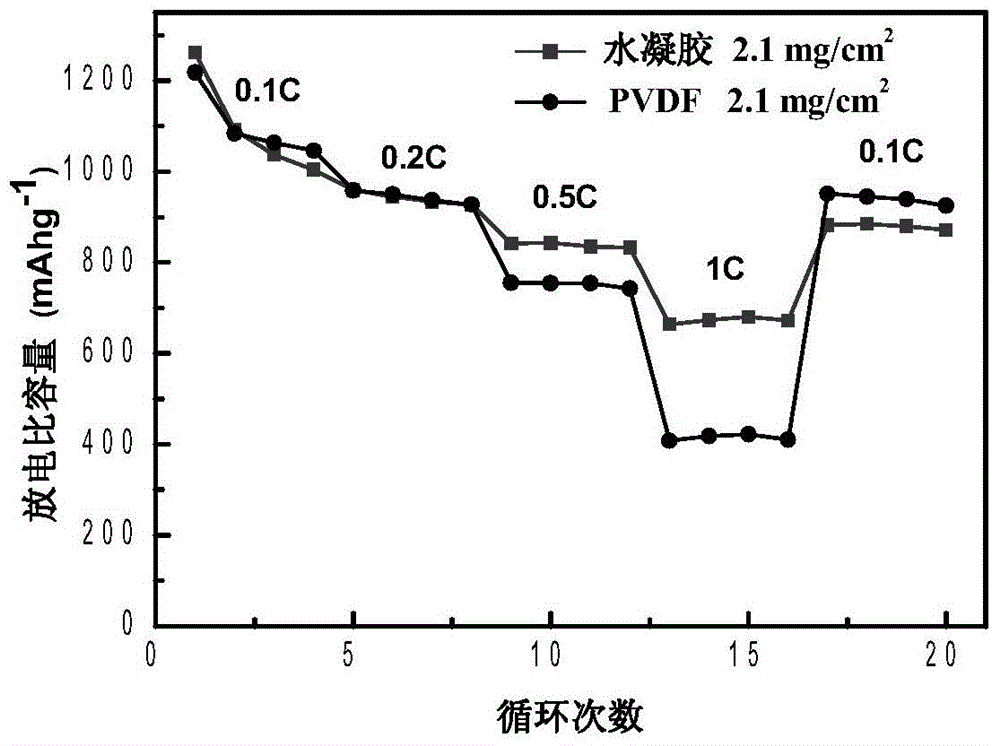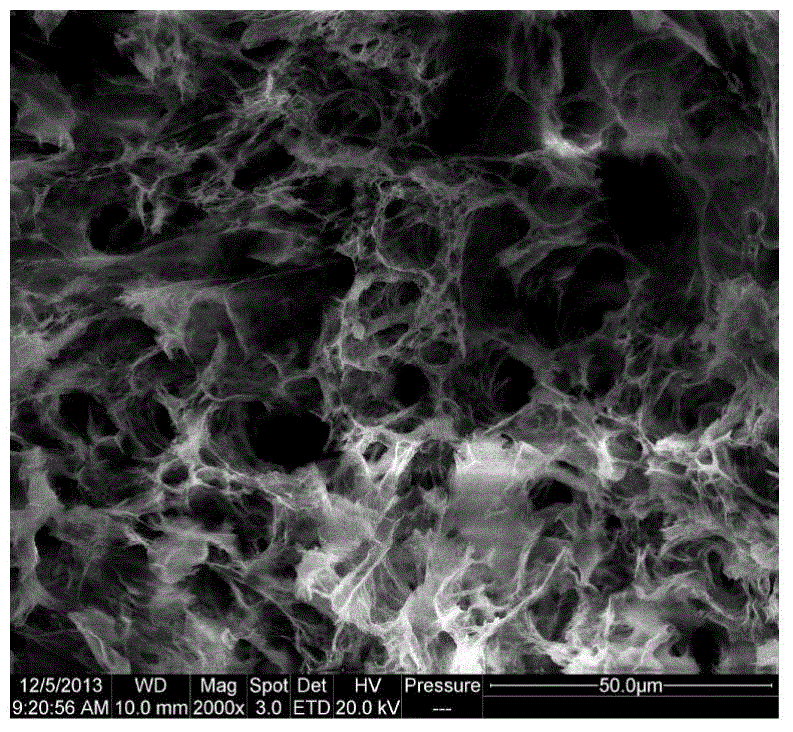Binder for lithium-sulfur battery and application of binder
A lithium-sulfur battery and binder technology, which is applied in lithium batteries, battery electrodes, non-aqueous electrolyte batteries, etc., can solve the problems of poor cycle performance of lithium-sulfur batteries, reduce agglomeration, shorten transmission distance, and ensure stability Effect
- Summary
- Abstract
- Description
- Claims
- Application Information
AI Technical Summary
Problems solved by technology
Method used
Image
Examples
Embodiment 1
[0034] a The gelatin was heated and stirred in deionized water for 1 h, the concentration of the gelatin aqueous solution was 3 wt %, and the heating temperature was 70° C. to obtain the gelatin aqueous solution.
[0035] b. Heat and stir polyvinyl alcohol (PVA) in deionized water for 3 hours, the concentration of the crosslinking agent aqueous solution is 10 wt %, and the heating temperature is 80° C. to obtain the PVA aqueous solution.
[0036] c. Heat and stir the starch in deionized water for 0.2 h, the concentration of the starch aqueous solution is 1%, and the heating temperature is 70° C. to obtain the starch aqueous solution.
[0037] d Add the cross-linking agent aqueous solution and starch aqueous solution to the prepared gelatin aqueous solution while heating and stirring, the mass ratio of cross-linking agent, starch, and gelatin is 10:2:1, the heating temperature is 80°C, and the stirring time is 2h. A mixed aqueous solution of the crosslinking agent gelatin starc...
Embodiment 2
[0044] a The gelatin was heated and stirred in deionized water for 1 h, the concentration of the gelatin aqueous solution was 3 wt %, and the heating temperature was 70° C. to obtain the gelatin aqueous solution.
[0045] b. Heat and stir polyvinyl alcohol (PVA) in deionized water for 3 hours, the concentration of the crosslinking agent aqueous solution is 10 wt %, and the heating temperature is 80° C. to obtain the PVA aqueous solution.
[0046] c. Heat and stir the starch in deionized water for 0.2 h, the concentration of the starch aqueous solution is 1%, and the heating temperature is 70° C. to obtain the starch aqueous solution.
[0047] d Add the crosslinking agent aqueous solution and starch aqueous solution to the prepared gelatin aqueous solution while heating and stirring, the mass ratio of crosslinking agent, starch, and gelatin is 15:3:2, the heating temperature is 80°C, and the stirring time is 2h. A mixed aqueous solution of the crosslinking agent gelatin starch ...
Embodiment 3
[0054] a The gelatin was heated and stirred in deionized water for 1 h, the concentration of the gelatin aqueous solution was 3 wt %, and the heating temperature was 70° C. to obtain the gelatin aqueous solution.
[0055] b. Heat and stir polyvinyl alcohol (PVA) in deionized water for 3 hours, the concentration of the crosslinking agent aqueous solution is 10 wt %, and the heating temperature is 80° C. to obtain the PVA aqueous solution.
[0056] c. Heat and stir the starch in deionized water for 0.2 h, the concentration of the starch aqueous solution is 1%, and the heating temperature is 70° C. to obtain the starch aqueous solution.
[0057] d Add the crosslinking agent aqueous solution and starch aqueous solution to the prepared gelatin aqueous solution while heating and stirring, the mass ratio of crosslinking agent, starch, and gelatin is 30:6:5, the heating temperature is 80°C, and the stirring time is 2h. A mixed aqueous solution of the crosslinking agent gelatin starch ...
PUM
 Login to View More
Login to View More Abstract
Description
Claims
Application Information
 Login to View More
Login to View More - R&D
- Intellectual Property
- Life Sciences
- Materials
- Tech Scout
- Unparalleled Data Quality
- Higher Quality Content
- 60% Fewer Hallucinations
Browse by: Latest US Patents, China's latest patents, Technical Efficacy Thesaurus, Application Domain, Technology Topic, Popular Technical Reports.
© 2025 PatSnap. All rights reserved.Legal|Privacy policy|Modern Slavery Act Transparency Statement|Sitemap|About US| Contact US: help@patsnap.com



